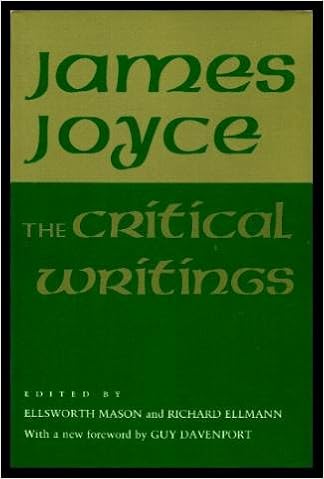 The first thing to know about this book is that its title is deceptive. A collection of 57 essays written by James Joyce between c1896 and 1937, it’s not so much “critically-important” reading for Joyceans, but Joyce engaged in writing critiques and critical essays. But is it essential reading for Joycean completists? Inasmuch as anyone who gets as far into Joyce as Ulysses generally becomes a completist (excepting some few who are scholastically-compelled to read it), the answer is probably yes. That doesn’t mean you’ll find yourself returning often to this book, even if you happen to be a professor who specializes in this author.
The first thing to know about this book is that its title is deceptive. A collection of 57 essays written by James Joyce between c1896 and 1937, it’s not so much “critically-important” reading for Joyceans, but Joyce engaged in writing critiques and critical essays. But is it essential reading for Joycean completists? Inasmuch as anyone who gets as far into Joyce as Ulysses generally becomes a completist (excepting some few who are scholastically-compelled to read it), the answer is probably yes. That doesn’t mean you’ll find yourself returning often to this book, even if you happen to be a professor who specializes in this author.
These essays are something of a mixed bag. You can certainly trace flashes of the evolution of Joyce’s critical thinking here, from childhood on. This is a matter of interest, of course: we garner new insights from a direction external to his fiction. Some of the journalism he produced which is reprinted here is so topical that it’s hard to relate to it now, and it’s probably not worth the amount of legwork that would be required to do so. Likewise for many of his book reviews of now forgotten works, and which he usually panned: no need to exhume those sub-literary corpses.
Still, there are occasional gems to be unearthed from the surrounding clayey strata. Joyce’s early preoccupation with the drama of the stage and his relegation of fiction to second-class status is made abundantly clear. We start getting to the “good stuff,” specifically to the “Aesthetics” section (1903/04), about half way through. Here we’re given access to entries from his Paris and Pola Notebooks in which he originally set down his aesthetic theory, featured prominently especially in A Portrait of the Artist as a Young Man. (There are some distinctions, but in truth most of this is laid out in that novel and is probably more readily digested there.) In 1907’s “Ireland, Island of Saints and Sages,” we begin to understand (as if we didn’t know already from his fiction) just how deep Joyce’s knowledge of Irish history and society extended. Later, some of his suggestions about Fenianism suggest we might revise our assumptions about Joyce’s celebrated pacifism; at a minimum we must conclude that Joyce-the-man was more complex than Joyce-the-myth. As of course every person is. “From a Banned Writer to a Banned Singer,” from 1932, is rather fascinating, as it is written in a style which might be dubbed Finnegans Wake-lite: a charming piece which by any other author’s standards hardly constitutes “lite” reading at all.
If you are a Joycean completist, and if you’ve bothered looking at this review then I’m sure you are, by all means you’ll want this book. You’ll probably be surprised to discover, even despite my review here, that it won’t be what you’d imagined it would be.
Tagged: Ellsworth Mason, James Joyce, Richard Ellmann